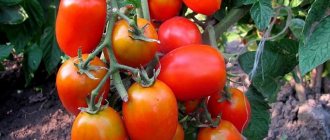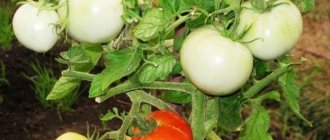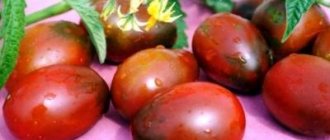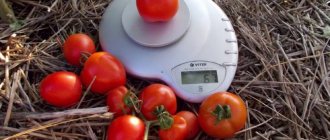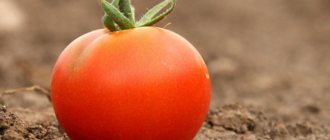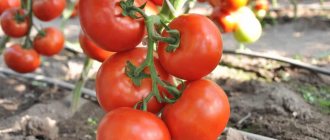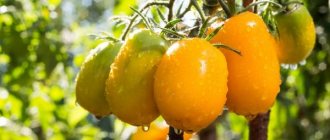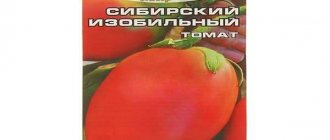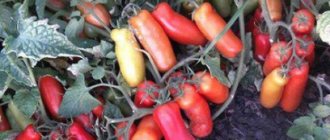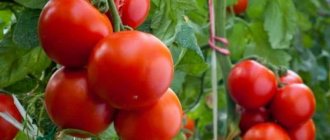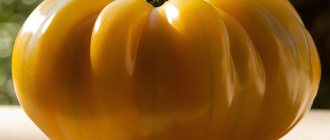Description of the variety
Tomatoes were included in the State Register of the Russian Federation in 2001. Breeders from the Federal Scientific Center for Vegetable Growing from the city of Barnaul grew a new variety in 1998. At that time, tomatoes were a crop that brought high yields only in the southern zones. Residents of the northern part of the country were unable to grow tomatoes in their beds: even with the standard development of the bush, ovaries did not form on it. Therefore, the goal of breeders was to invent a variety that would bear fruit in short, cool and rainy summers.
The climatically unstable Volgo-Vyatka, West Siberian, East Siberian and Far Eastern regions became the regions for growing Demidov’s tomato. Summer residents of the Central Federal District also appreciated Barnaul tomatoes.
Distinctive features
Demidov is a determinate standard (low-growing) variety. Height - 65 cm. Mid-ripening: fruits ripen 101–109 days after the appearance of the first shoots. The bush is medium leafy and produces few branches.
The leaves are potato-shaped, rich green in color, wide. This saves the inflorescences when humidity increases, for example, from dew, which often appears after sudden changes in night and day temperatures (difference of 7–11 °C). After 6-7 pairs of leaf blades, the first flowers form; after the raceme, they form after 1-2 leaves.
Tomatoes can easily tolerate sudden changes in weather conditions.
Fruit characteristics and yield
As can be seen in the photo, the fruits at the stage of biological maturity acquire a pink tint. Other properties of Barnaul tomato:
- round, slightly flattened shape;
- the skin is smooth;
- ribbing at the stalk;
- fleshy, tasty, sugar pulp;
- 4 seed chambers;
- weight - 80–120 g.
When carrying out the simplest agricultural work (regular and sufficient watering, fertilizing the soil), up to 9 kg of fruits are obtained from 1 m2.
Peculiarities
The Demidov tomato variety withstands sudden temperature changes. This is due to the rather low bushes, which, after the onset of cold weather, seem to “draw” heat from the heated ground.
This variety is suitable for cultivation by those who have just decided to try their hand at gardening, since Demidov does not need to be pinched, formed inflorescences, tied up, etc.
Good to know ! Pinching is an opportunity to significantly increase productivity (experienced gardeners know). With its help, you can make sure that the soil gives the maximum amount of nutrients to certain stems.
After planting the seedlings, about 110 days pass before the first tomatoes appear. But it all depends on the specific region and compliance with all the rules for planting and caring for the plant. Especially on the number of warm and sunny days.
Demidov is grown not only in the garden, but also in greenhouses, under films, on balconies, etc. From 1 sq.m. In the end, you can get about 10 kg of plantings. large, juicy and tasty tomatoes.
The main purpose of this variety is to use it in various salads. It is also often used for canning, for various preparations, pickles, etc.
How to grow seedlings
Demidovs are grown both with the help of seedlings and without them (the seeds are planted directly on the beds in May-June). In the first case, seed planting begins in 60–65 days.
Seed preparation
Agronomists recommend including 7 basic procedures in preparing seed material. When carrying them out, follow the sequence, but if any stage is uninteresting or seems difficult, just skip it and move on to the next one.
Start preparing a month before sowing:
- Calibration _ Empty the seeds from the package and examine them. For planting, select large, even seeds. Set aside small, crooked, empty ones to the touch - you won’t be able to get a good harvest from them. Test the seeds with a salt solution: add a tablespoon of salt to a glass of water and place the grains there. After 20 minutes, discard those that float to the surface; they will not sprout.
- Warming up . Dry the seeds. Place them in a cotton bag and hang it from the radiator for 2-3 weeks. Those who like to do everything quickly place the seeds on a cloth and place them on a cardboard sheet on a heating radiator. In this case, the duration of the procedure is from 36 to 48 hours. Some summer residents advise placing the seeds in a newspaper envelope, which is wrapped in cotton cloth and laid out on the radiator. This saves space and prevents seeds from being accidentally scattered.
- Disinfection . Prepare a 1% solution of potassium permanganate: add 1 g of potassium permanganate to 100 ml of water. For accurate measurements, use scales, since if the ratio is incorrect, there is a high risk of destroying the seed material. If this option does not work, try measuring the powder by eye. In this case, dissolve a teaspoon of potassium permanganate (6 g) in 2 glasses of water (600 ml). The duration of disinfection of tomato seeds is 20 minutes. The 1% solution is almost black in color, so don't be alarmed if the seeds become colored after soaking. Plant agronomy experts say that treating grains with a less concentrated solution will not have a disinfecting effect. After disinfection is completed, rinse the grains with running water.
- Sparging (oxygen saturation). Place the planting material in warm (+26 to +30 °C) water and stir every hour for 15–18 hours. For convenience, use an aquarium compressor. If the seeds begin to germinate, interrupt the procedure.
- Soaking . Place the seeds in warm water (from +26 to +30 °C) or a solution of a biostimulating drug. Experienced farmers prefer to use Zircon, Epin, sodium humate and Energen (in liquid form). The duration of the procedure is 12 hours. Summer residents also advise soaking seeds in aloe juice. To do this, wrap the leaves of the plant in paper and put them in the refrigerator for 2 weeks. Then squeeze out the juice and mix it in a 1:1 ratio with warm water. Soaking time is 24 hours.
- Hardening . Wrap the seeds in cloth and film and place on the bottom shelf of the refrigerator for 8 hours. Then place it in a room at room temperature for 8 hours. Repeat 5-6 times.
- Germination . Leave the seeds on gauze or cotton cloth in a flat bowl and moisten with warm water. The temperature of the room where the seeds will be located should not be lower than +21 °C. Make sure to keep the fabric damp at all times. If necessary, moisten it with water (+25 to +30 °C). When embryos 2-3 mm in size appear on the grains, begin planting.
Container and soil
Buy a container for seedlings in specialized stores or make one from scrap materials. Plastic cups, cut-off bottles, dairy product packaging, and PET cake lids are great for this.
Buy soil mixture at the store. The composition of the universal tomato soil includes:
- humus;
- peat;
- river sand.
You can prepare the soil mixture yourself by combining:
- garden soil - 1 part;
- non-acidic peat - 2 parts;
- sand - 0.5 parts;
- humus or sifted mature compost - 1 part.
Add wood ash or dolomite flour, sphagnum moss and fallen pine needles.
Before planting, treat the soil and containers with boiling water or a weak solution of potassium permanganate.
Sowing
Fill the containers 2/3 full with soil. Moisten the soil generously, make grooves 1 cm deep in it. Place the seeds at a distance of 2-3 cm from each other. Cover with a thin (1-2 cm) layer of soil and moisten the soil with a spray bottle.
Cover with plastic wrap (for small containers, use thin plastic bags) to create a greenhouse effect and place the containers in a dark and warm (+22 to +28 °C) place.
Growing and care
As soon as the first green heads appear from the ground, remove the film. Water the seedlings as the soil dries under the roots using a teaspoon or syringe. When two true leaves appear, plant the tomatoes in separate containers. Add mineral fertilizers to the new soil at the rate of 1 tbsp. spoon per 5 liters of soil. Dig the seedlings down to the cotyledon leaves.
10 days after picking, feed the seedlings with complex fertilizer. Add them every 14 days. 2-3 weeks before transplanting to the garden, start hardening off the tomatoes. In the first days, take it out into the open air for 3-4 hours, placing the containers in the shade. Gradually increase the time you spend outside and the amount of sunlight. 2-3 days before transplanting, leave the seedlings outside overnight.
Important ! Seedlings standing on a windowsill will lean towards the sun, so rotate the containers every day.
Carefully monitor the formation of inflorescences. It is advisable to transplant the plants to the site before the first flowers appear. Otherwise, the tomato takes a long time to take root, is delayed in development, and fruiting begins later than the date indicated by the manufacturer.
History of creation
Tomatoes of the Demidov variety are among the most sought after on the market today. Which is not surprising, because these tomatoes are not fussy to care for, and their taste will appeal to any gourmet. The variety was bred by Russian scientists in the 21st century and recommended for cultivation in the Volga-Vyatka and West Siberian regions of the country.
For the most part, Demidov tomatoes are used for making salads; they are also excellent for fresh consumption. The variety is so widespread that Demidov tomatoes can be found in almost every market of any city in Russia: from the capitals of Moscow and St. Petersburg to small provincial towns.
Tomato Demidov
Characteristics and features of the variety
Tomato Demidov belongs to the mid-season species. Its characteristics and description of the variety are in many ways similar to many hybrid tomatoes. From the emergence of seedlings to the ripening of the fruit, a little more than 100 days pass. Determinate standard bushes are weakly branched and can grow up to 65 cm in height.
The leaves are shaped like potatoes, have a dark green color and are medium in size.
The variety in question does not have F1 hybrids of the same name, which means it cannot be classified as a hybrid. The bushes easily tolerate changes in weather, and the fruits set well, regardless of the changed conditions.
Basically, the Demidov tomato, the characteristics and description of the variety of which are similar to many low-growing species, is not afraid of any diseases. But with infrequent watering, blossom end rot is possible. With this disease, dark circles appear on the fruits, and the pulp underneath begins to rot. On the contrary, if you overwater the tomatoes, there is a risk that the tomatoes will crack.
Tomato Demidov - a low-growing species
The variety differs from other varieties in its round tomatoes. Until the fruits are ripe, you can see a dark green spot at the stalk, and the tomatoes themselves will be greenish. When they are ripe, the color will change to pink. Each tomato has 4 nests, the dry matter content reaches 4%.
The inflorescences are simple. The first, as a rule, is formed above the 6th and 7th leaves. The rest are 1-2 sheets apart. Flowers are capable of self-pollination.
Ripe tomatoes can weigh up to 120 grams. They are famous for their excellent taste and ability not to spoil for a long time. Many gardeners prefer to collect them when they are green and leave them to ripen at home. Under favorable conditions, up to 450 centners of crop can be harvested from one hectare.
Agricultural technology
At the end of March or beginning of April, it is necessary to sow seeds for seedlings. Until the sprouts appear, it is recommended to cover the box with polyethylene to create conditions similar to those in a greenhouse. The variety cannot be called frost-resistant. It grows and develops easily in an open area, but does not tolerate a significant decrease in temperature.
Sowing tomatoes for seedlings
When the leaves hatch, it is better to place the container on the most illuminated windowsill. After some time, several full leaves will form. This means it’s time to pick the plant in separate glasses.
During growth, seedlings need feeding. It needs to be fertilized with mineral mixtures, the procedure must be carried out three times.
About 6-7 days before planting tomatoes in open ground, they should be hardened off. An excellent way is to gradually reduce the temperature of the water when watering until the mark is 1-2 notches lower than usual.
From May 15, you can take seedlings to a tomato greenhouse or greenhouse. At the beginning of summer, feel free to transfer it to open ground.
Planting tomato seedlings in open ground
When planting and further care, you need to consider a few little things. Firstly, the distance between rows should be at least 60 cm, and between bushes - about half a meter. Secondly, it is recommended to water in the evening with warm water heated in the sun. Otherwise, burns may appear on the leaves. Thirdly, it is very important to carry out hilling and weeding. This will strengthen the tomato root system. Don't forget about fertilizers. During the season it is necessary to add mineral mixtures at least 3 times.
Pavlovsk breed of chickens: description and characteristics of the breed
Demidov tomatoes are unpretentious. Some pests can cause damage to them. The most common parasites include the Colorado potato beetle, aphids and spider mites. To combat them effectively, experts recommend resorting to insecticides. If desired, you can get rid of the problem mechanically, catching the pests one by one.
Aphids on tomato seedlings
How to grow tomatoes
After 60–65 days, transplant the tomatoes to the site. Check the weather conditions in your region.
Landing
Plant Demidov tomatoes according to the 50*60 pattern (4 bushes per 1 m2). Some summer residents thicken the plantings and plant in a 40*50 pattern (6 bushes per 1 m2).
2-3 days before transplanting, water the seedlings generously. To ensure that the roots grow thicker and the plant receives more nutrients from the soil, cut off the cotyledons and a couple of lower leaves with a sharp blade.
Dig holes the size of a ball of earth and the height of the stem to the first pair of leaves, water generously with warm, settled (rain) water.
Important ! Plant seedlings on cloudy days or evening hours. This promotes rapid recovery of the plant.
Use the transshipment method: remove the bush from the pot along with the earthen ball, lower it into the hole, dig it with earth up to the cotyledon leaves and compact it. Spray with water again.
Care
Water the seedlings as the soil dries with warm water and only in the evening. Immediately loosen and weed the soil around the bushes. 2 weeks after transplanting, earth up the tomatoes. Repeat the procedure after 2-3 weeks.
Once every 14 days, feed vegetables with complex and mineral fertilizer.
It will not be superfluous to spray with foliar fertilizers: wood ash, boric acid solution.
Do not tie up or shoot tomatoes. It is not necessary.
There are no difficulties in growing Demidov tomatoes. The main thing is not to allow the soil to dry out, but also not to over-moisten it, especially during the period of fruit ripening. The first will lead to the formation of blossom end rot, and the second will lead to cracking of the skin of the fruit.
Diseases and pests
Manufacturers of the variety claim that the tomato has high resistance to diseases and pests.
However, untimely watering can cause blossom end rot to form on the plant. With a lack of water and high air temperature, moisture evaporates from the leaves and stem and the plant begins to consume it from the ripening fruits. As a result, brown, dry spots form on them.
Important ! Top rot also actively develops when there is a lack or excess of calcium, the plant is oversaturated with nitrogen and the increased acid content in the soil.
Therefore, the primary prevention of the disease is proper watering. If signs of the disease are detected, begin treatment immediately. Remove the affected parts of the plant and burn them. Spray the plantings with calcium nitrate (7–10 g per 10 liters of water) or potassium chloride (30 g per 10 liters of water). Of the traditional methods, the most effective is a soda solution (20 g of soda per 10 liters of warm water).
Tomatoes are susceptible to attack by various pests:
- White dots appear on the undersides of leaves from spider mite puncture sites. Later, the vegetables are enveloped in a thick web. They get rid of the pest by spraying tomatoes with alcohol or a tincture of dandelions, tobacco, garlic and horseradish roots. Special means are also suitable (for example, “Anti-mite”).
- It is difficult not to notice the Colorado potato beetle in plantings. In spring and summer, the pest migrates to tomatoes from potatoes. The drugs “Prestige”, “Iskra”, etc. are good against it. The leaves and stems are treated several times during the summer. To destroy beetle larvae, use a mixture of water, ash and laundry soap.
- In summer, plants are attacked by aphids. It sucks all the juices out of the tomatoes and makes them lethargic. To combat insects, solutions of karbofos or bleach are used. A mixture of ash and soap is effective.
To prevent the appearance of pests, bushes are treated with insecticides.
Subtleties of cultivation
Demidov tomatoes are grown only as seedlings. In the southern regions it can be sown directly into the ground, but there it is better to select your own zoned tomatoes.
Warning! Seedlings should be planted at the age of 55-60 days. Seedlings with inflorescences and an open root system take root worse.
Seedling care
Demidov tomato seeds are sown in containers in March-April. It is necessary to calculate the timing based on the moment of transferring the seedlings to a permanent place. Plants are planted in greenhouses in May, and in gardens no earlier than June.
- Shoots appear in 5-10 days. If until this moment the temperature was maintained at 250 C, now it must be lowered by 8-9 degrees so that the sprouts do not weaken and quickly stretch upward;
- A week later, when the young shoots of tomatoes have leveled off, the heat is raised to a temperature comfortable for this plant - 230 C;
- For good and uniform development, tomato seedlings need additional lighting. It is advisable to purchase special phytolamps for this;
- If the plants are on a windowsill, the container should be rotated once or twice a day;
- Water young tomatoes sparingly;
- When the second leaf appears, the seedlings are picked.
Comment! If possible, it is better to plant each plant separately in cups. When transferred to the ground, the root system will be practically preserved, and the seedlings will take root faster.
Plants on the site
According to reviews from those who planted Demidov tomatoes, it is advisable to immediately install blanks for film covering above the bed. In case of threat of frost, this guarantees the preservation of plants. They are planted according to a 50x60 cm pattern, although the descriptions contain advice that these tomatoes can be placed up to six plants per square meter.
The specificity of caring for Demidov tomatoes is that they must be watered in a timely manner, and the soil must not be allowed to dry out in order to avoid the development of blossom end rot or cracking of the fruit. For irrigation, use warm water, which has been heated in containers all day. The best option is drip irrigation, then the soil is moistened evenly and water does not fall on the plants.
After watering, the soil is loosened and weeded to remove weeds. After the first week in the garden, the stems are earthed up. Another hilling of plants is carried out after two to three weeks. This technique helps the bushes form additional roots.
Top dressing
Use organic or mineral fertilizers.
- Prepare a mixture of liquid mullein - 0.5 liters, 20 g of nitrophoska, 5 g of potassium sulfate, 30 g of superphosphate per 10 liters of water. 0.5-1 liter of nutrient solution is poured under each bush;
- Tomatoes are fertilized by foliar feeding with preparations that make plants less susceptible to low or high temperatures - Brexil Ca, Megafol, Gumifield, SVIT.
This variety is easy to grow. And the fruits will be guaranteed.
Growing in open ground and in a greenhouse
There are no differences in growing tomatoes in shelter and without it. An undeniable advantage of greenhouses is the ability to create the microclimate necessary for heat-loving vegetables. This leads to higher plant yields than in open ground.
An important nuance of growing tomatoes in a greenhouse is watering: in a shelter, tomatoes are irrigated only in the morning. In the evening, condensation may form on them, which will be a good environment for the development of fungal diseases. Remember the need to regularly ventilate greenhouses. Trim the lower foliage as soon as the fruits begin to turn red.
In open ground, water the tomatoes 2-3 hours before sunset with warm water, strictly at the root.
Harvesting and application
Tomatoes ripen at 101–109 days. The fruits are used fresh. They are not suitable for whole-fruit pickling. They are used to prepare lecho, sauces and juices for the winter. Demidov tomatoes tolerate transportation and long-term storage well, which is why they are often grown for sale by large farms.
Interesting ! You can collect seeds from tomatoes for further planting.
Diseases and pests
Demidov tomatoes are often affected by blossom end rot. This disease is expressed in the formation of brown spots on the top of the fruit. The pulp under such spots begins to rot.
To prevent this disease, tomatoes need to be regularly watered and foliar fertilizing using special preparations. One of the most famous drugs is Brexil Ca. You can also use Gumifield, SVIT and Megafol.
“Demidov” tomatoes are highly valued by gardeners for their many positive qualities, which more than compensate for the minor shortcomings of this variety.
Advantages and disadvantages of the variety
The undoubted advantage of Demidov tomatoes is their unpretentiousness. In addition, tomatoes are loved by Russian summer residents for:
- resistance to cold and temperature changes;
- immunity to diseases and pests;
- productivity;
- taste.
The variety has no significant disadvantages. Some people call susceptibility to blossom end rot and fruit cracking a disadvantage. However, these problems can be avoided by following simple agricultural practices.
Qualitative characteristics of the plant and fruits
The very fact that the Demidov tomato remains popular for a long time suggests that it has much more advantages than disadvantages.
Advantages
One of the main qualities of this tomato variety plant is that it is intended for growing in gardens, without shelter.
- The tomato variety is hardy: the plant develops well, forms ovaries and produces excellent, large fruits even with minimal care and in the event of unfavorable weather conditions in the Siberian summer;
- There are not so many branches formed on the plant for the bush to become dense. Thanks to this property, caring for tomatoes is simplified;
- The plant exhibits excellent resistance to diseases inherent in tomatoes, and therefore does not require special attention;
- Productivity is high. Demidov tomatoes are grown in industrial production, although the figures vary in different regions: 150-300 centners per hectare in the Volga-Vyatka region; about 200-400 c/ha – in West Siberian;
- Large fruits have a seductive presentation. Up to 98% of high-quality tomatoes suitable for trade are harvested from the plantation;
- The structure of the pulp makes it possible to collect fruits in the phase of incomplete ripeness for ripening;
- The fruits of this tomato variety are valued for their characteristic tomato taste, juiciness and sweetness.
Flaws
Unfortunately, the fruits are susceptible to cracking if not watered correctly. Typically, the skin of tomato fruits bursts when, after a period of drought, the tomatoes are watered abundantly and the fruits gain moisture. If the rains fall evenly, the fruits become filled with pulp and at the same time the volume of the skin increases, it remains intact.
The next negative characteristic of these tomatoes is their susceptibility to blossom end rot if the soil is not moistened on time. During periods of drought, the roots cannot feed the tomato bush. Then moisture actively evaporates from the leaves of the plant. The set fruits give up some of their moisture to the plant. Its outflow occurs precisely from the top of the fetus, where some of the cells die. The area of the fetus softens and rots. Now various fungal spores can become attached to it.
We can say that this phenomenon is the scourge of almost all tomatoes, because it is a rather delicate plant.
Farmer reviews
Experienced gardeners note the taste, productivity and unpretentiousness of the variety.
Maria Pskovina, Velikiye Luki: “I grew Demidova before, it’s very decent. Powerful low bush, pink fruits of good taste, average yield. I don’t remember any illnesses, but I didn’t seem to suffer much. I remember that I was disappointed in the canning - the tomatoes were cracked, but if you don’t pickle them whole, it’s quite acceptable. A worthy variety, plant for good health!”
Victor Semenov, Kulikovka village: “ I am an experienced summer resident. Previously, I grew varieties with tall bushes. I constantly had to think about gartering the bushes. A neighbor recommended the Demidov variety. It's just earth and sky. And there were so many tomatoes that I treated all my relatives and friends.”
Alexander Dorin, Novosibirsk: “I’ve been working with tomatoes for several years now. I plant the Demidov variety in open ground. Foliar feeding helps a lot - the fruits are all the same. They look attractive. Good variety."
Dmitry Olegov, Pskov: “Demidov has been growing in our garden for many years. Moreover, we are not covering him with anything. These tomatoes are very resistant and hardy, and are not afraid of temperature changes. The taste is simply great. I have never tasted anything better in my life. I recommend this variety to all my friends.”
Tomato Demidov on video
If you grew Demidov tomatoes, please write whether you liked them or not. What was the yield and taste of the fruit? Will you grow them again? How do you rate the disease resistance of this tomato? Briefly describe what, in your opinion, are the advantages and disadvantages of this tomato. If possible, attach to the comment a photo of the entire bush as a whole or individual fruits that you grew. Thank you!
Your reviews of the Demidov tomato and additions to the description will help many gardeners evaluate this variety more objectively and decide whether it is worth planting or not.
A website about tomatoes is always at your service - Tomatland.
